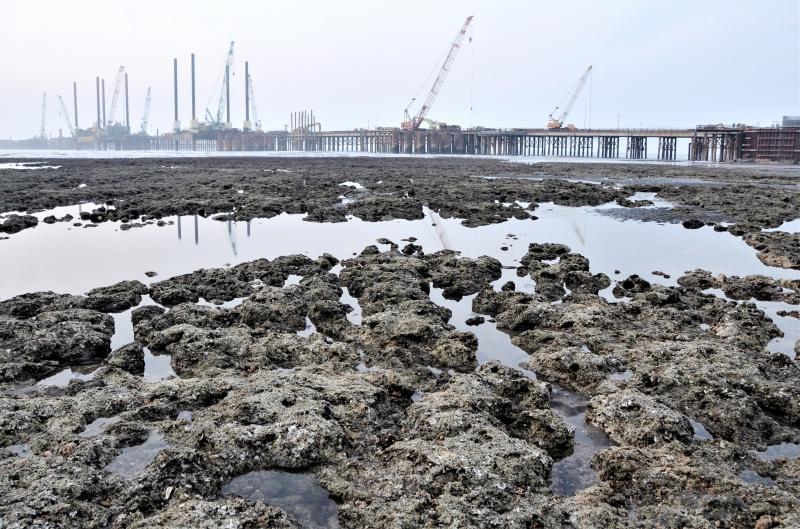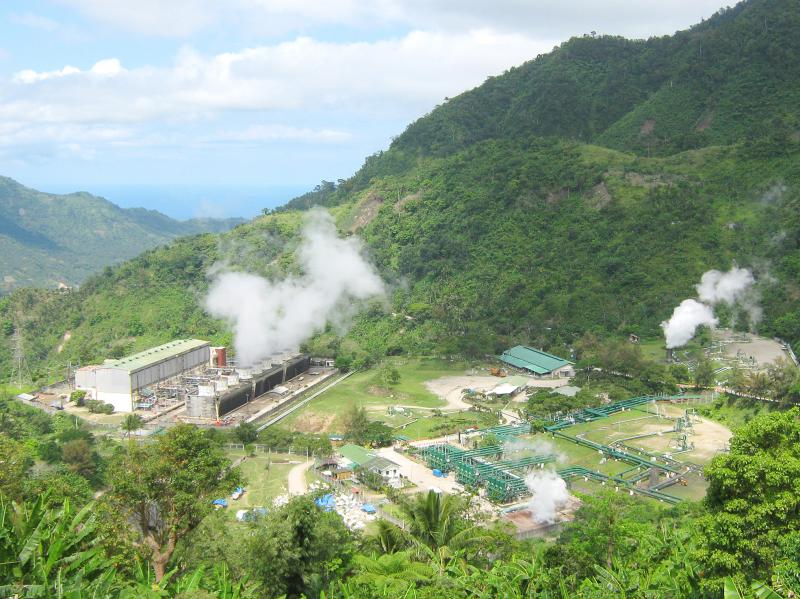Last week saw two interesting developments in fossil fuels. ExxonMobil shareholders forced the company management to accept two board members who want the giant polluter to take meaningful action on climate change. That same day, a Dutch court found that Shell is partially responsible for climate change and ordered the company to dramatically curtail its carbon emissions.
These landmark developments remind us of the urgency of switching away from fossil fuels to a clean energy future.
In Taiwan, we face referendums in August that touch on this: the public must decide on the issues of algal reefs vs liquid natural gas development, and activating the Fourth Nuclear Power Plant, a revenant to be summoned from the grave by the magic of public agreement.

Photo: Cheng Shu-ting, Taipei Times
The referendums highlight just how retrograde the thinking is in Taiwan on the environment-energy relationship. How orthogonal to the real problems it is. What a stupid game our politics are.
GEOTHERMAL POWER
The algal reefs in Taoyuan are almost all dead, slain not by liquid natural gas projects but by plumes of pollution from hundreds of unregulated factories that operated in Taoyuan for decades. Even if the liquid natural gas (LNG) project never goes through, the remaining factories will finish the last few kilometers of reefs sooner or later.

Photo courtesy of Wikimedia Commons
If only the energy we put into screaming at each other about the referendum were put into regulating our factories, the LNG project wouldn’t matter. All the factory owners who made a killing killing those reefs must be laughing their butts off in Shenzhen with the factory they built there on dead reef money.
Likewise, the Fourth Nuclear Plant is a big engineering project. Technological megaprojects always feel like they are modernization made real, giving them a special appeal to a people reared on the teats of Taiwan’s modernizing developmentalist state. Shiny white plants with big cooling towers! Feels like the future!
The truth is that nukes are an aging technology kept alive on the life support of state subsidies. Moreover, as Keith Barnham of the Imperial College of London (see False solution: Nuclear power is not ‘low carbon’) and others have noted, nuclear plants are insufficiently low carbon, once their entire life cycle is taken into account.
Thus, to turn to nukes is to make a backwards turn to our developmentalist past. We need another future.
Imagine if the referendum were about urgently funding another power solution we have right at hand.
A few tens of kilometers to the south, there is a country that gets around 12 to 15 percent of its power from a technology that is still moving into its technological future: geothermal. The US is first in the world with roughly 2500 to 3000 megawatts (MW) of installed capacity, Philippines is second with around 1900MW of installed geothermal capacity. We can learn from our brother to the south.
Taiwan at present isn’t even a blip on the geothermal radar. Yet we should be a global leader. A 2016 survey of Taiwan’s geothermal resources showed that Taiwan may have as much as 160 gigawatts (GW) of electrical power potential with geothermal, with about 33.6GW of that representing exploitable geothermal energy. That 33GW is a substantial proportion of the island’s power demand, and geothermal is 24/7 baseload power.
For Taiwan, geothermal power offers massive advantages over nuclear power. The “fuel” is produced right in Taiwan. Geothermal plants are not a threat to contaminate nearby population centers when there is a disaster, nor can they be used as hostages in a war like nuke plants. Unlike nukes, geothermal is truly low carbon.
Ramping up geothermal technology and geothermal power investment would enable the island to develop a supercluster of firms that provide geothermal power systems, hardware, software, and power development services. A whole new export sector, based on homegrown power systems.
Taiwan has failed to push solar power domestically the way it should have. Let’s not make that mistake with another future energy form.
ENERGY SUPERGRIDS
Investments will naturally lead to improvements in technology, which will enable us to harvest even more of our geothermal resources. What to do with all that excess energy, and the energy we could be getting from solar thermal and PV systems? Sell it, of course, to our neighbors.
Researchers are already proposing energy supergrids that would permit export of power across thousands of kilometers of sea (the technology already exists). A 2019 paper by R. Itiki et al proposes a supergrid connecting Japan, Taiwan, and the Philippines. “This proposed offshore HVdc interconnector,” they describe, “would support power trading between Japan, Taiwan, Philippines, Indonesia, and Australia.”
The cable would follow the chain of islands south from Okinawa to Taiwan, and then across the Bashi Channel. South from Philippines it would cross Indonesia via West Papua, and then reach Australia. High voltage DC converter stations would be erected at intervals on the route.
Crazy, you say? Such cables are already under construction. At present the longest is the 1,200km EuroAsia Interconnector, which connects Greece and Israel via Cyprus, with one section nearly 900km long. None of the sections of the proposed Japan-Taiwan-Philippines supergrid are that long.
Whatever form it takes, a power grid that connects Taiwan with its neighbors could turn Taiwan into a net energy exporter running on geothermal and solar, while stimulating a whole new cluster of industries on the island providing its hardware and software and sales and marketing services.
We could be imagining a day when Australian solar thermal power runs air conditioners and semiconductor etching machines in Taiwan, while Taiwanese geothermal powers small factories in Luzon and keeps sake factories in Shikoku at just the right temperature. The political advantages of growing such important links with our neighbors should be obvious.
Instead, we are imagining a day when we restart a dead project that likely was never meant to function. The noise generated by the pro-nuke side has glossed over the numerous irregularities with the plant’s construction and suppliers. The public has forgotten that the Chinese Nationalist Party (KMT) proposed killing it only after all the money had been spent and the plant was almost completed, as if to ensure that its patronage networks had been properly fed and watered.
As Nathan Batto, the locally-based political scientist, once asked, “How many schools, hospitals, roads, public housing, MRT lines, or flower festivals were sacrificed for [the nuclear plant]?” A list to which could be added urgently needed power conservation, solarization, and renewable energy investments. All wasted.
Let’s not do that again. Another future awaits, if we have the imagination for it.
Notes from Central Taiwan is a column written by long-term resident Michael Turton, who provides incisive commentary informed by three decades of living in and writing about his adoptive country. The views expressed here are his own.

That US assistance was a model for Taiwan’s spectacular development success was early recognized by policymakers and analysts. In a report to the US Congress for the fiscal year 1962, former President John F. Kennedy noted Taiwan’s “rapid economic growth,” was “producing a substantial net gain in living.” Kennedy had a stake in Taiwan’s achievements and the US’ official development assistance (ODA) in general: In September 1961, his entreaty to make the 1960s a “decade of development,” and an accompanying proposal for dedicated legislation to this end, had been formalized by congressional passage of the Foreign Assistance Act. Two

March 31 to April 6 On May 13, 1950, National Taiwan University Hospital otolaryngologist Su You-peng (蘇友鵬) was summoned to the director’s office. He thought someone had complained about him practicing the violin at night, but when he entered the room, he knew something was terribly wrong. He saw several burly men who appeared to be government secret agents, and three other resident doctors: internist Hsu Chiang (許強), dermatologist Hu Pao-chen (胡寶珍) and ophthalmologist Hu Hsin-lin (胡鑫麟). They were handcuffed, herded onto two jeeps and taken to the Secrecy Bureau (保密局) for questioning. Su was still in his doctor’s robes at

Last week the Democratic Progressive Party (DPP) said that the budget cuts voted for by the China-aligned parties in the legislature, are intended to force the DPP to hike electricity rates. The public would then blame it for the rate hike. It’s fairly clear that the first part of that is correct. Slashing the budget of state-run Taiwan Power Co (Taipower, 台電) is a move intended to cause discontent with the DPP when electricity rates go up. Taipower’s debt, NT$422.9 billion (US$12.78 billion), is one of the numerous permanent crises created by the nation’s construction-industrial state and the developmentalist mentality it

Experts say that the devastating earthquake in Myanmar on Friday was likely the strongest to hit the country in decades, with disaster modeling suggesting thousands could be dead. Automatic assessments from the US Geological Survey (USGS) said the shallow 7.7-magnitude quake northwest of the central Myanmar city of Sagaing triggered a red alert for shaking-related fatalities and economic losses. “High casualties and extensive damage are probable and the disaster is likely widespread,” it said, locating the epicentre near the central Myanmar city of Mandalay, home to more than a million people. Myanmar’s ruling junta said on Saturday morning that the number killed had